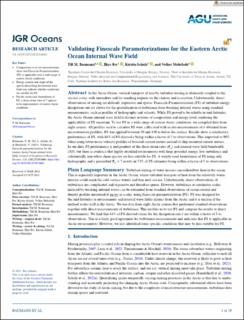| dc.description.abstract | In the Arctic Ocean, vertical transport of heat by turbulent mixing is ultimately coupled to the sea-ice cover, with immediate and far-reaching impacts on the climate and ecosystem. Unfortunately, direct observations of mixing are difficult, expensive and sparse. Finescale Parameterization (FS) of turbulent energy dissipation rate (ɛ) allows for the quantification of turbulence from breaking internal waves using standard measurements, such as profiles of hydrography and velocity. While FS proved to be reliable in mid-latitudes, the Arctic Ocean internal wave field is distinct in terms of composition and energy level, rendering the applicability of FS uncertain. To test FS in a wide range of eastern Arctic conditions, we compiled data from eight cruises. All profiles used to calculate FS were collocated with in-situ measurements of ɛ obtained from microstructure profilers. FS was applied between 50 and 450 m below the surface. Results show a satisfactory performance of FS, with 84% of FS-derived ɛ being within a factor of 5 to observations. This improved to 90% when using lower-noise velocity profiles of lowered current meters instead of ship-mounted current meters. In our data, FS performance is independent of the shear-strain ratio (Rω) and internal wave field bandwidth (N/f), but there is evidence that highly stratified environments with large potential energy, low turbulence and substantially non-white shear spectra are less suitable for FS. A widely used formulation of FS using only hydrography and a prescribed Rω = 7 results in 73% of FS estimates being within a factor of 5 to observations. | en_US |
